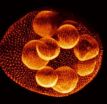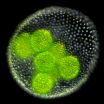(Press-News.org) Researchers from the University of Cambridge have captured the first three-dimensional images of a live embryo turning itself inside out. The images, of embryos of a green alga called Volvox, make an ideal test case to understand how a remarkably similar process works in early animal development.
Using fluorescence microscopy to observe the Volvox embryos, the researchers were able to test a mathematical model of morphogenesis - the origin and development of an organism's structure and form - and understand how the shape of cells drives the process of inversion, when the embryo turns itself from a sphere to a mushroom shape and back again. Their findings are published today (27 April) in the journal Physical Review Letters.
The processes observed in the Volvox embryo are similar to the process of gastrulation in animal embryos - which biologist Lewis Wolpert called "the most important event in your life." During gastrulation, the embryo folds inwards into a cup-like shape, forming the primary germ layers which give rise to all the organs in the body. Volvox embryos undergo a similar process, but with an additional twist: the embryos literally turn themselves right-side out during the process.
Gastrulation in animals results from a complex interplay of cell shape changes, cell division and migration, making it difficult to develop a quantitative understanding of the process. However, Volvox embryos complete their shape change only by changing cell shapes and the location of the connections between cells, and this simplicity makes them an ideal model for understanding cell sheet folding.
In Volvox embryos, the process of inversion begins when the embryos start to fold inward, or invaginate, around their middle, forming two hemispheres. Next, one hemisphere moves inside the other, an opening at the top widens, and the outer hemisphere glides over the inner hemisphere, until the embryo regains its spherical shape. This remarkable process takes place over approximately one hour.
Previous work by biologists established that a specific series of cell shape changes is associated with various stages of the process. "Until now there was no quantitative mechanical understanding of whether those changes were sufficient to account for the observed embryo shapes, and existing studies by conventional microscopy were limited to two-dimensional sections and analyses of chemically fixed embryos, rendering comparisons with theory on the dynamics difficult," said Professor Raymond E. Goldstein of the Department of Applied Mathematics and Theoretical Physics, who led the research.
The interdisciplinary group of Cambridge scientists obtained the first three-dimensional visualisations of Volvox inversion and developed a first mathematical model that explains how cell shape changes drive the process of inversion.
Their time-lapse recordings show that during inversion one hemisphere of the embryos shrinks while the other hemisphere stretches out. While previous studies on fixed embryos have also observed this phenomenon, the question was if these changes are caused by forces produced within the invaginating region, or from elsewhere in the embryo.
Through mathematical modelling, the researchers found that only if there is active contraction of one hemisphere and active expansion of the other does the model yield the observed 'mushroom' shape of an inverting Volvox globator embryo.
"It's exciting to be able to finally visualise this intriguing process in 3D," said Dr Stephanie Höhn, the paper's lead author. "This simple organism may provide ground-breaking information to help us understand similar processes in many different types of animals."
These results imply that any cell shape changes happening away from the invagination region seem to be due to active forces intrinsic to the cell, rather than through passive deformations. Since analyses in animal model organisms mostly concentrate on cell shape changes that happen within an invaginating region, the model could be used to make those analyses far more accurate.
"The power of this mathematical model is that we can identify which cell deformations are needed to cause the embryo movements that we observe in nature," said Dr Aurelia Honerkamp-Smith, one of the study's co-authors.
The experimental and theoretical methods demonstrated in this study will be expanded to understand not only the peculiar inversion process but many mysteries concerning morphogenesis. The mathematical model may have applications in a multitude of such topological problems, such as the process of neurulation that leads to the enclosure of the tissue that eventually becomes the spinal cord.
INFORMATION:
Other members of the research team were PhD students Pierre A. Haas (DAMTP) and Philipp Khuc Trong (Physics).
This work was supported by an Earnest Oppenheimer Early Career Fellowship, the EPSRC, and the European Research Council.
Barcelona, Spain: Results from a randomised controlled trial to compare the use of permanent radioactive implants (brachytherapy) with dose-escalated external beam radiotherapy in patients with prostate cancer show that the men who received brachytherapy were twice as likely to be cancer-free five years later.
Presenting these results at the 3rd ESTRO Forum in Barcelona, Spain, today (Monday) Professor James Morris, from the Department of Radiation Oncology, Vancouver Cancer Centre, British Columbia Cancer Agency (BCCA), Vancouver, Canada, will say that the ASCENDE-RT1 ...
Barcelona, Spain: Radiotherapy using protons can deliver more accurate treatment to a tumour while reducing the dose to surrounding tissue. However, in mobile organs such as the lung, precise targeting of the dose is difficult. Now researchers have succeeded in making a model of breathing movement that allows for the precise measurement of narrow beams to a dummy tumour by simulating the motion and physical properties of the chest anatomy in a model, the 3rd ESTRO Forum in Barcelona, Spain, will hear today (Monday).
Dr Rosalind Perrin, from the Centre for Proton Therapy ...
Millions of people are dying from common, easily treatable conditions like appendicitis, fractures, or obstructed labour because they do not have access to, or can't afford, proper surgical care, according to a major new Commission, published in The Lancet.
The Commission reveals that five billion people worldwide do not have access to safe and affordable surgery and anaesthesia when they need it, and access is worst in low-income and lower-middle income countries, where as many as nine out of ten people cannot access basic surgical care.
Just under a third of all deaths ...
The team led by Dr Sheena Cruickshank of the Faculty of Life Sciences and Professor Andy Brass from the School of Computer Science analysed 58 papers on research into inflammatory bowel disease published between 2000 and 2014. They found a wide variety in how methods were reported and that vital information about experiments were missing, meaning they couldn't be accurately reproduced in animal or human models.
In several instances the gender of the animal used wasn't recorded which can have a bearing on the result as female mice have a stronger immune response to males. ...
SAN DIEGO - New research shows that it doesn't take much for kids to be considered couch potatoes.
Kindergartners and first-graders who watched as little as one hour of television a day were more likely to be overweight or obese compared to children who watched TV for less than 60 minutes each day, according to a study to be presented Sunday, April 26 at the Pediatric Academic Societies (PAS) annual meeting in San Diego.
Efforts to fight the childhood obesity epidemic have focused on getting kids to be more active. Previous studies have shown that children who watch ...
SAN DIEGO - Adults can have a bigger influence on youths growing up in poor, violent neighborhoods than they may realize, according to a study to be presented Sunday, April 26 at the Pediatric Academic Societies (PAS) annual meeting in San Diego.
Researchers found that males living in Philadelphia who identified supportive relationships with parents and other adult family members were significantly less likely to report that they were involved in violence or had witnessed violence.
"This is good news. In neighborhoods with high levels of community violence and few ...
SAN DIEGO - Since it's nearly impossible to keep mobile devices out of the hands of children, they might as well learn something worthwhile using these devices. That was the idea behind the development of a game app to teach youngsters about bicycle and dog bite safety.
Researchers will present the results of a study looking at the effectiveness of the app on Sunday, April 26 at the Pediatric Academic Societies (PAS) annual meeting in San Diego.
"Despite recommendations for children to have limited screen time, the reality is young children are using mobile devices, ...
SAN DIEGO - Teens no longer smoke just cigarettes. They have branched out to using alternative tobacco products such as electronic cigarettes, hookahs and little cigars. In fact, e-cigarette use is rising rapidly among both cigarette smokers and nonsmokers, according to a study to be presented Sunday, April 26 at the Pediatric Academic Societies (PAS) annual meeting in San Diego.
"Electronic cigarettes are of great concern. They are highly addictive nicotine delivery devices, and the vapor can and does cause harm to lungs," said principal investigator Jonathan D. Klein, ...
SAN DIEGO - When schools close their doors for the summer, many low-income children who rely on subsidized breakfasts and lunches don't know when they will get their next meal. An innovative program to fill this gap could serve as a model for communities looking to help feed struggling families when school is out.
Results of a study evaluating the impact of the summer feeding program will be presented on Sunday, April 26 at the Pediatric Academic Societies (PAS) annual meeting in San Diego.
In early 2012, Lisa Chamberlain, MD, MPH, FAAP, a pediatrician at a community ...
SAN DIEGO - Smartphones and tablets have become part of everyday life, but parents still worry that mobile devices may not be the best thing for their children, according to a study to be presented Sunday, April 26 at the Pediatric Academic Societies (PAS) annual meeting in San Diego.
The scientific literature has not kept pace with how technology is affecting family life. To help fill this gap, researchers conducted in-depth interviews with 35 parents/guardians to learn about their views regarding mobile device use by themselves and their children, including benefits, ...

